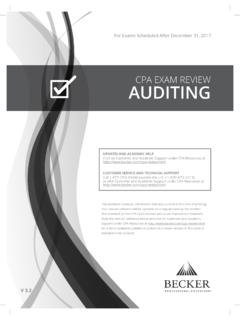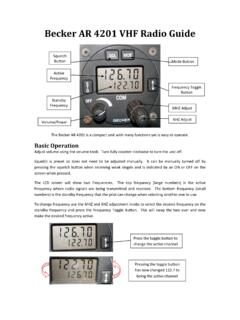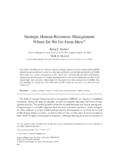Transcription of CPA EXAM REVIEW REGULATION - cpa-tac.com
1 For exams Scheduled After December 31, 2018 CPA EXAM REVIEWREGULATIONV HELPC lick on Customer and Academic Support under CPA Resources at SERVICE AND TECHNICAL SUPPORTCall 1-877-CPA-EXAM (outside the +1-630-472-2213) or click Customer and Academic Support under CPA Resources at textbook contains information that was current at the time of printing. Your course software will be updated on a regular basis as the content that is tested on the CPA Exam evolves and as we improve our materials. Note the version reference below and click on Replacement Textbooks under CPA Resources at to learn if a newer version of this book is available to be of ContentsRegulationxiii Becker Professional Education Corporation. All rights of ContentsProgram Attendance Record .. xiIntroduction ..Intro- 1 REGULATION 1: Individual Taxation: Part 11. Filing Requirements and Filing Status.
2 R1- 32. Gross Income: Part 1 ..R1- 133. Gross Income: Part 2 ..R1- 274. Items From Other Entities ..R1- 415. Loss Limitations for Individuals ..R1- 536. Employee Stock Options ..R1- 61 REGULATION 2: Individual Taxation: Part 21. Adjustments ..R2- 32. Itemized Deductions ..R2- 133. Tax Computation and Credits ..R2- 254. AMT and Other Taxes ..R2- 45 REGULATION 3: Property Taxation1. Basis and Holding Period of Assets ..R3- 32. Taxable and Nontaxable Dispositions ..R3- 113. Gains and Losses ..R3- 274. Related Party Transactions ..R3- 395. Cost Recovery ..R3- 45 REGULATION 4: Corporate Taxation1. Corporate Formation ..R4- 32. Corporate Taxable Income ..R4- 93. Differences Between Book and Tax ..R4- 194. Tax Computations and Credits ..R4- 255. Consolidated Tax Returns ..R4- 316. NOLs and Capital Loss Limitations ..R4- 377. Entity/Owner Transactions ..R4- 43xivRegulationTable of Contents Becker Professional Education Corporation.
3 All rights 5: Flow-Through Entity Taxation and Multi-jurisdictional Tax Issues1. S Corporations ..R5- 32. Partnerships: Part 1 ..R5- 173. Partnerships: Part 2 ..R5- 254. Partnerships: Part 3 ..R5- 375. Multi-jurisdictional Tax Issues ..R5- 436. International Tax Issues ..R5- 57 REGULATION 6: Other Entity Taxation, Professional Responsibilities, and Federal Tax Procedures1. Trusts and Estates ..R5- 32. Estate and Gift Transactions ..R5- 113. Tax-Exempt Organizations ..R5- 214. Circular 230 ..R6- 275. Professional Responsibilities and Tax Return Preparer 376. Federal Tax Procedures ..R6- 477. Legal Duties and Responsibilities ..R6- 59 REGULATION 7: Business Law: Part 11. Agency ..R7- 32. Contracts: Part 1 ..R7- 153. Contracts: Part 2 ..R7- 254. Contracts: Part 3 ..R7- 395. Suretyship ..R7- 556. Secured Transactions ..R7- 65 REGULATION 8: Business Law: Part 21.
4 Bankruptcy: Part 1 ..R8- 32. Bankruptcy: Part 2 ..R8- 153. Federal Securities REGULATION ..R8- 254. Other Federal Laws and regulations ..R8- 435. Business Structures: Part 1 ..R8- 516. Business Structures: Part 2 ..R8- 65 Class Question Explanations ..CQ- 1 Blueprint ..BL- 1 Glossary ..GL- 1 Index ..Index- 11 REGI ndividual Taxation: Part 1 Module 1 Filing Requirements and Filing Status ..3 2 Gross Income: Part 1 ..13 3 Gross Income: Part 2 ..27 4 Items From Other Entities ..41 5 Loss Limitations for Individuals ..53 6 Employee Stock Options ..611 Filing Requirements and Filing StatusModule 1 Filing Requirements and Filing Status Becker Professional Education Corporation. All rights 3 REG 1 REG 1 Module1 Individual Income Tax FormulaThis module begins the discussion of individual income tax. The formula below provides a summary of the calculation of taxable income and federal income tax liability or refund for individuals.
5 Ultimately, these items are reported on the individual income tax return, Form income< Adjustments >Adjusted gross income< Standard deduction >Or< Itemized deductions >Taxable income before QBI deduction< QBI deduction >Taxable incomeFederal income tax< Tax credits >Other taxes< Payments >Tax due Or Refund1 Filing Requirements and Filing StatusModule 1 Filing Requirements and Filing Status1 Filing Requirements and Filing Status Becker Professional Education Corporation. All rights 4 REG 12 Taxable Income Formula for IndividualsTaxable income is the base for the individual income tax. The formula below demonstrates the calculation of taxable income for individual incomeWagesInterestDividendsState tax refundsAlimony received*Business incomeCapital gain/lossIRA incomePension and annuity Rental income/lossK-1 income/lossUnemployment compensationSocial Security benefitsOther income< Adjustments >Educator expensesIRAS tudent loan interest expensesHealth savings accountMoving expenses**One-half self-employment taxesSelf-employed health insuranceSelf-employed retirementInterest withdrawal penaltyAlimony paid*Adjusted gross income< Itemized deductions >Medical (in excess of percent of AGI)Taxes state/local (income/sales and property, up to $10,000)Interest expense (Home and Investment)Charity (up to 60 percent of AGI)Casualty/theft attributable to federal disaster (in excess of 10 percent of AGI)
6 Taxable income before QBI deduction< QBI deduction >Taxable income* Under the Tax Cuts and Jobs Act (TCJA) for all divorce or separation agreements executed after 12/31/18, alimony received will not be included in gross income and alimony paid cannot be deducted.**Only for members of the armed forces moving pursuant to military Filing Requirements and Filing StatusModule 1 Filing Requirements and Filing Status Becker Professional Education Corporation. All rights 5 REG 13 Filing Requirements for Who Must File?The first consideration when thinking about individual taxation is who must file a tax return. Generally, a taxpayer must file a return if his or her income is equal to or greater than the sum of:1. the regular standard deduction (except for married filing separately), plus2. the additional standard deduction amount for taxpayers age 65 or older or blind (except for married persons filing separately).
7 When to Due Date April 15 Individual taxpayers must file on or before the 15th day of the fourth month following the close of the taxpayer's taxable year, which is April Extension Automatic Six-Month Extension to October 15: An automatic six-month extension (until October 15) is available for those taxpayers who are unable to file by the April 15 due date. The automatic six-month extension is not an extension for the payment of any taxes owed. Although granted automatically, the six-month extension must be requested by the taxpayer by filing Form 4868 by April 15. Payment of Tax: Even with an extension, the due date for payment of taxes remains April 15. 4 Filing Single (Use the End-of-Year Test)You are considered unmarried for the whole year if, on the last day of your tax year, you are either: unmarried or legally Joint Returns (Use the End-of-Year Test)In order to file a joint return, the parties must be married at the end of the year, living together in a legally recognized common law marriage, or married and living apart (but not legally separated or divorced).
8 If married during the year, a joint return may be filed, provided the parties are married at year-end. This includes same-sex couples legally married under state law (as a result of the Supreme Court case Obergefell v. Hodges (2015), same-sex couples have the right to marry in all states). If divorced during the year, a joint return may not be filed. If one spouse dies during the year, a joint return may be 1 Filing Requirements and Filing Status1 Filing Requirements and Filing Status Becker Professional Education Corporation. All rights 6 REG Married Filing SeparatelyA married taxpayer may file a separate return even if only one spouse has income for the year. In a separate property state, a husband and wife who elect to file using the married filing separately status must separately report their own income, credits, and deductions on their own individual income tax returns.
9 In a community property state, most of the income, deductions, credits, etc., are split 50 Qualifying Widow(er) With Dependent Child Two Years After Spouse's Death: A qualifying widow(er) is a taxpayer who may use the joint tax return standard deduction and rates for each of two taxable years following the year of death of his or her spouse, unless he or she remarries. In the event of a remarriage, the surviving spouse will file a tax return (joint or separate) with the new spouse. Principal Residence for Dependent Child: The surviving spouse must pay over half the cost of maintaining a household where a dependent child lives for the whole taxable year. The dependent child must be a child (including an adopted child but not a foster child) or stepchild of the surviving Head of HouseholdHead of household status entitles certain taxpayers to pay lower taxes.
10 The lower tax results from a larger standard deduction and "wider" tax brackets. To qualify, the following conditions must be met:1. The individual is unmarried, legally separated, or married and has lived apart from his or her spouse for the last six months of the year as of the close of the taxable The individual is not a "qualifying widow(er)."3. The individual is not a nonresident The individual maintains as his or her home a household that, for more than half the taxable year, is the principal residence of a qualifying person, including a dependent child, parent, or relative (as discussed below). A Qualifying ChildChild, stepchild, legally adopted child, foster child, brother or sister, or a descendant of one of these who meets the definition of a dependent under the qualifying children Father or Mother (Not Required to Live With Taxpayer)A dependent parent is not required to live with the taxpayer, provided the taxpayer maintains a home that was the principal residence of the parent for the entire year.





